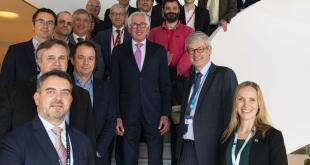
As previously reported in SpaceWatch.Global, South Korea has followed through on its threat to change the preferred bidder for its five-satellite reconnaissance constellation, tapping Korea Aerospace Industries (KAI) to lead the programme.
The Defense Acquisition Program Administration (DAPA) named the consortium of local Korea Aerospace Industries, along with Hanwha Systems and French company Thales Alenia Space, as the preferred bidder for the U.S.$930 million satellite project code-named 425, scheduled for launch by 2023.
The consortium made up of local company LIG Nex1, Satrec Initiative, and German-based Airbus Defence and Space, had been given status as preferred bidder last December. But, according to defence sources quoted in Defense News, the negotiations broke down because the LIG Nex1 team failed to meet the proposed specifications of the reconnaissance satellites.
“The negotiation between the Agency for Defense Development in charge of the 425 project, and the LIG Nex1-led consortium has been ruptured, as the sides were not able to narrow the differences over the development of satellite prototypes,” a DAPA spokesman said. “We’ll begin negotiations with the second preferred bidder on May 3.”
“After being chosen as the preferred bidder, the LIG Nex1 consortium is said to have asked the ADD to lower the specifications regarding the number of imaging acquisition, the standards of image quality and other things,” said Rep. Kim Jong-dae of the minor opposition Justice Party, a member of the National Assembly’s Defence Committee, in Defense News. “The consortium is known to have asked to change 29 out of 129 specifications it had proposed to win the contract.”
The 425 project will develop four satellites fitted with synthetic aperture radar (SAR) and one satellite to obtain infrared and high-resolution electro-optical images. DAPA uses SAR satellites to collect intelligence on key facilities in North Korea.
The LIG Nex1-Airbus team participated in developing South Korea’s multipurpose Arirang-6 satellite, with a SAR system included. That satellite was originally scheduled for launch in 2019. The plan, however, was delayed by 13 months because of problems with SAR technology transfer and integration. Still, the KAI-led consortium says it remains confident in satisfying the due requirements.
“We’ll try our best to meet the requirements, as we have plenty of experiences developing and delivering satellites, including one with the SAR system,” an official of Hanwha Systems told Defense News.
KAI, the country’s only aircraft developer, has delivered five multipurpose satellites, including the Arirang-5 with SAR functionality. Thales, which ran a joint venture with Hanwha, also participated in multiple South Korean satellite projects.
The South Korean military currently operates the Arirang-3 multipurpose satellite to acquire geographical information on the Korean Peninsula, including North Korea’s missile and nuclear test sites. But the country heavily relies on the U.S. for much of its intelligence due to the commercial satellite’s limited capabilities.





